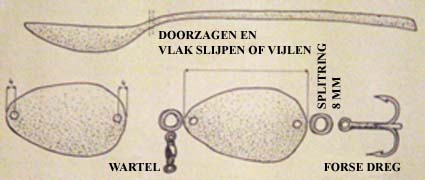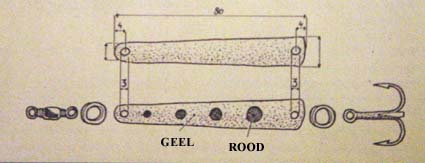

Making your own spoons and pirks.
In the old days
preaching anything new. In the old days skippers made their own spoons too.
They made quite easely from broken soup-spoons. Back then they didn't have as many tools as we do now: a pair of wire-cutters, a hammer and some wire to make some sort of splitring and that's about it. The spoons was attached to a strong line, usually rope, that was trolled behind a slow ailing ship and it was ready to catch some pike. By reducing or increasing the length of the rope they more or less were able to adjust the running-depth of the spoons. The fact that already 40to 70 years ago people thought about lure-presentation, can be determined by all the resources they used to keep the spoon at depth or close to the side of the boat.
They made special planks from oak-wood in which they drilled holes, all at certain distances from eachother, that served as attachment-eyes both for the spoons and the line. The front had a certain angle which caused the plank to be pulled down like a crankbait. When they pulled the plank straight after a take, it came to the surface quickly and they could easely land the pike. Similar planks are still being used in countries that have a tradition in trolling lures. These are often called 'seehund' or 'ente'.

From used items
If we take a look at what we need to make our own spoons and pirks, the first thing we come across are real spoons. These real spoons can be tea-spoons, soup-spoons, dessert-spoons and whatever other spoon there may exist. You'll probably have some of these lying around in your kitchen drawer that are no longer being used. It's probably best though to ask for your husband's/wife's permission, this may eliminate a lot of domestic troubles.
Even better is a visit to a flee-market? Often you can buy a supply of old spoons for a nickle and a dime. Also check for old knifes too. From the handle you can make some fine pirks! Especially the somewhat heavier pirks can be used in deep and fast flowing waters. The trick is to choose spoons with a thin blade and some with a thicker blade. The thin ones can be used in shallower waters, the thicker ones in deeper waters or for trolling. All that remains is adding trebles, strong splitrings and some swivels to complete your spoon.
In this case buy the best material you can get. Cheap = weak. So pay your local tacklestore a visit and ask for strong trebles, swivels and splitrings. It's best to get them in different sizes. For a bigger spoon you'll need bigger trebles than for a small tea-spoon. The same goes for swivels and splitrings.
Maybe now there are some readers who'll say: "I don't use swivels, there is no use for them" Maybe, but without these, your line will kink fairly quickly. A spoon with a swivel is always best.

Not a tough job
We'll start with the spoon. Take an old spoon and saw off the handle. Don't throw it away though, we'll be using that one later. Then drill a hole of at least 3mm diameter in each end of the sawed off spoon. Choose the thinnest end of the spoon as the top, this is usually the narrowest side, though the other way around works just as well but gives a different action. First add a splitring and then the swivel. Attach a splitring and the treble on the other end. But be sure to choose a big enough treble hook. For the average spoon consider that the width of the spoon should be about the distance between two hooks of the treble. Now the spoon is ready and can be attched to your rod right away.
From the sawed off handle we'll build a pirk. From the widest end of the handle we measure about 8cm (3.25") and saw off the rest of the thinner end. We round off the two ends with a file or a powertool so there are no sharp edges left. Next drill two holes of about 3mm diameter and remove any metal splinters from the inside of the hole. To finish the pirk, all you need to do is add splitrings, a swivel and a treble. Another way to attach the pirk to your line would be by using a snap-swivel instead of a swivel and a splitring. Make sure though that this snap-swivel is strong and has a large pullingstrength to land a big codd. To achieve a different action, just use the thinner end to measure the 8cm and saw off the leftover from the thick end. This gives the pirk a different action.
If you feel that adding a different color to your spoons adds to its catching ability, you can add some red or yellow paint to it. There's no limit to what you can paint on them. Try adding a large twistertail to the treble, there's so much you can try to get better results. The only thing left to do, is go out and fish and I hope that you'll do well on your 'homemade' lures.
Dirk de Boer (printed with permission of Poask Hengelsport)
Source: Voor en door de Visser and Poask Hengelsport



